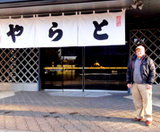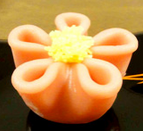【第四十七回目】
とらや:五感で味わう和菓子の魅力
Toroya:Japanese Confectionery―A Pleasure for the Five Senses
Toroya:Japanese Confectionery―A Pleasure for the Five Senses
 今日おうかがいしたのは、和菓子の老舗「とらや」。1520年代(室町時代後期)に京都で創業した菓子店です。早速、広報部の松平さんにお話をうかがいましょう。 Today we’re visiting Toraya, a long-established Japanese confectionery (wagashi) shop started in Kyoto in the 1520s. The comments from Matsudaira-san, from the public relations department, give us insight into what makes puts Toraya at the very top of the prestigious wagashi industry in Japan. |
|
| (松平) | ようこそ、セインさん。こんにちは。 Hello, Mr. Thayne-san, welcome. |
| はじめまして。セインです。 早速、質問したいのですが、「とらや」という店の名前は、どういう理由でつけられたのですか?動物のトラと関係がありますか? Nice to meet you. I’m Dave Thayne. I’d like to get started by asking whether there was a reason for naming the store shop Toraya? Does it have anything to do with the animal tiger (tora). |
|
| (松平) | はい、とらやの“とら”は動物のトラと関係があります。 昔の日本人にとって、トラは、書物などで存在は知っているけれど見たことはない動物、でも強くて勇猛で躍動感にあふれる生き物だと想像されていました力強 くさまざまな力を発揮する霊獣のように考えられていました。そうした神秘的な虎の名を名乗るということは、虎の持つ力にあやかろうという気持ちの表れとも 考えられます。室町時代後期に創業しましたが、残念ながら、とらやにこうした点をはっきり記した文献は残っていません。 Yes, Toraya comes from the word for tiger. For ancient Japanese, the tiger was an animal that you’d read about in books but never see; and it was also believed that tigers were strong and had powers―a holy creature from China. It is believed that the reason for using the name of a godly creature was to reflect the power of the tiger. Sadly, no official documents that state the actual reasons for this remain. |
| 500年近くもお菓子屋さんを続けているのですね。 ところで、このお茶と一緒に出してくださったお菓子、とってもきれいですね。 So you’ve been in business for nearly 500 years now? By the way, this treat that you served us with tea is beautiful. |
|
 季節の生菓子「寒紅梅」(*訪問したのは2月初め) 季節の生菓子「寒紅梅」(*訪問したのは2月初め)Seasonal Japanese-style unbaked Kan-ko-bai (Note: Interview held in early February) |
|
| (松平) | ありがとうございます。「寒紅梅」という名前の菓子です。どうぞ、お召し上がりください。 セインさんは和菓子を初めて召し上がった時、どんな印象を持たれましたか? Thank you very much. This wagashi is called Kan-ko-bai. Please try it. Thayne-san, what was your first impression when you first tried Japanese-style desserts? |
| 「期待していたものと違う。甘くない」と思いました。アメリカのお菓子は、すごく甘いですから。 そして、正直言うと、「おいしいかどうか」はよくわかりませんでした。僕だけじゃなくて、外国人で和菓子を食べて、最初から「おいしい」と言う人は少ない んじゃないでしょうか。豆類を甘く味つけする、というところでまず違和感があるんだと思います。ですから、何度か食べているうちに、だんだんわかってくる という感じだと思います。 They weren’t as sweet as I had imagined they would be. American desserts are really sweet. To tell you the truth, I wasn’t quite sure if I would like it or not. It’s not just myself―there probably aren’t many foreigners who would think that it tastes good the first time they try it. I think it may seem odd to them to make beans taste sweet. But the more you eat wagashi the more you’ll come to enjoy it. |
|
| (松平) | そういうお話は今までにも聞いたことがあります。 Actually, we’ve heard that before too. |
| それから、和菓子というのは大人のお菓子なんだということを思いました。アメリカ人は大人も子どもも同じお菓子を食べますけれど、日本には大人のお菓子があるのだと。 Another thing is that wagashi seems to be a dessert for adults. In America, kids and adults eat the same kinds of sweets, but in Japan, there are sweets that seem to be specifically for older people. |
|
| (松平) | 大人の菓子……そう言えるかもしれませんね。 和菓子は「五感の芸術」と言われています。素材のほのかな香りを楽しみ、色や形を楽しみ、楊枝で切る時の触感を楽しみ、味を楽しむ。そして最後の一つは、お菓子の名前を聞いて楽しみます。 Sweets for adults…that maybe be so. Wagashi is said to be an art that pleases the five senses. You’re able to fully enjoy it―the subtle aroma of the ingredients, the shapes and colors, the texture, when you cut into it, the taste, and finally the sound of the carefully chosen name. |
| 「寒紅梅」という名前を聞くだけで、今、ちょうど見頃を迎えている梅を思い浮かべる……とか。 Just by hearing the name Kan-ko-bai you can imagine the plum trees in full bloom. |
|
| (松平) | 何かに「見立て」て作られた菓子を、感覚を研ぎ澄まして受け取って、イマジネーションを膨らまして楽しむことができるんです。 You’re able to enjoy the entire experience with a heightened sense of feeling to build on your imagination of the dessert and what it portrays. Wagashi made to resemble certain objects can be fully appreciated if you take them in with a heightened sense and use your imagination. |
| 僕がお菓子を「五感」で楽しむまでになるのは、大変そう~。 I think it’ll take me some time before you can fully understand and enjoy the five senses of Japanese-style sweets. |
|
| (松平) | 外国の人に和菓子のよさをわかっていただけるにはどうしたらいでしょう。何かヒントをいただけませんか? How do you think we could better get foreigners to understand this concept? Do you have any suggestions? |
| 外国人が和菓子と出会って感動するのは、まず見た目の美しさだと思います。味はわかりにくくても、色と形の素晴らしさはすぐに、誰にでもわかる。そこをもっとアピールしていくことから始めたらどうでしょうか。 I think the first thing foreigners will recognize how beautiful wagashi is. They may not quite understand the taste, but anyone can appreciate the unique colors and shapes. I think if you could appeal to these strong points, it would be best. |
|
| 日本のお菓子のデザインは、ほんとうに世界一ですね。外国のかたを日本のデパートのお菓子売り場につれていくとびっくりされます。商品はもちろん、パッケージも含めてすばらしい、と。 The design of Japanese desserts is unsurpassed. When foreigners are taken to the wagashi sections of Japanese department store, they’re astonished by not only the item itself, but by the entire presentation, including the packaging. |
|
| そう!日本では、お菓子は人にプレゼントするものという使い方があるんですね。だから、お菓子にも価値がある。とらやさんでも、ギフト用のお菓子がたくさん売られているでしょう? Yes! In Japan, people give sweets as gifts, so maybe that’s why there is a demand for high quality. Does Toraya sell a lot of wagashi as gifts? |
|
| (松平) | はい、かなりの割合でギフトにお使い頂いています。 Yes, a large percentage is purchased as gifts. |
| おー、やっぱり!日本人は親切だし他人への思いやりがあるから、お菓子をお土産に持っていくんですね。欧米では人に会うのにお菓子を持っていくという習慣はほとんどありません。 Ah, I knew it! Japanese are so kind and thoughtful towards other people, so they often buy sweets as gifts and take it when they visit. The tradition of wagashi as a gift does not exist so much in Western countries. |
|
| アメリカで心からお礼を言いたいときにはどうするんですか? In America, when you want to express your appreciation towards something or someone, how do you usually do it? |
|
| 「Thank you!」って大きい声で言う。(全員大笑) We just say simply say, “Thank you!” (Laughing) 480年の歴史のなかで、とらやのお菓子は全部で何種類作られてきたんですか? |
|
| (松平) | 約3000種あります。 There are currently about 3,000 different kinds. |
| すごーい! Amazing! |
|
| (松平) | 年にいくつかの新商品を開発していますので、今も少しずつ菓子の種類は増えていっています。 We develop a few new desserts each year, so the number has grown little by little. |
| 今日は、和菓子の魅力がまた少しわかったような気がしました。 ありがとうございました! Thank you for your time. I think today we’re better able to understand the concept of wagashi. |
|
| (文)太田美代 (英訳)デイビッド・A・セイン |
 1959年、米国生まれ。証券会社勤務を経て来日し、翻訳・通訳など多岐にわたって活躍。豊富な教授経験を生かし、数多くの英語関係書籍を執筆。近著に『日本人のチョットへんな英語』(アスコム)、『超入門シャドーイング』(主婦の友社)、日本人が使いすぎる英語(PHP文庫)など多数。
1959年、米国生まれ。証券会社勤務を経て来日し、翻訳・通訳など多岐にわたって活躍。豊富な教授経験を生かし、数多くの英語関係書籍を執筆。近著に『日本人のチョットへんな英語』(アスコム)、『超入門シャドーイング』(主婦の友社)、日本人が使いすぎる英語(PHP文庫)など多数。下町の魅力に魅了され、自身が代表を務める英語関連のコンテンツ会社のエートゥーゼットのオフィスを根津に構えている。英会話本の執筆をしながら、東京・文京区根津と春日にあるエートゥーゼット英語学校の校長も務める。
http://www.smartenglish.co.jp/







